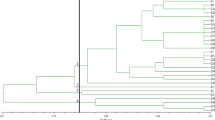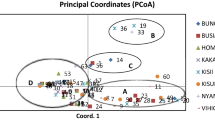Abstract
Background
Germplasm identification is an essential connection linking the conservation and exploitation of crop genetic resources in several plant breeding programs. This study highlights the biochemical and molecular variations in a collection of pumpkin genotypes representing four climate zones. The information could help improve germplasm management and sustainable exploitation of the neglected genotypes.
Methods and results
Chemical characterization and genetic diversity among nine Egyptian landraces of pumpkin (Cucurbita moschata Duchesne) were estimated using Diode Array (DDA) Near Infra-Red (NIR) technology and the Inter simple Sequence Repeat markers (ISSR). Pumpkin seeds were collected from various geographical parts of Egypt. The spectroscopic properties of pumpkin seeds were used to quantify the fat, moisture, protein, ash, fiber, and total carbohydrate contents. The ten ISSR primers generated a total number of 46 genotype-specific bands, and the total polymorphism produced in the tested landraces was 63.58%. Based on the ISSR data, the polymorphism analysis divided the nine pumpkin landraces into two main groups, two subgroups, and four sub subgroups. The most diverse pumpkin landraces were Alexandria and Sohag, with a similarity percentage of 49.6%. However, the highest calculated similarity value was 88.3% between Matruh and Gharbia. The resultant genotype-specific bands can be used as markers for future genotypic characterization of pumpkins.
Conclusions
The study results could be helpful in the chemical phenotypic characterization and the parental selection and planning for future breeding programs for pumpkin improvement.





Similar content being viewed by others
Data availability
The datasets used or analyzed during the current study are available from the corresponding author upon reasonable request.
References
Wehner TC, Naegele RP, Myers JR, Dhillon NPS, Crosby K (2020) Cucurbits, 2nd edn. CABI, Wallingford
Peiretti PG, Meineri G, Gai F, Longato E, Amarowicz R (2017) Antioxidative activities and phenolic compounds of pumpkin (Cucurbita pepo) seeds and amaranth (Amaranthus caudatus) grain extracts. Nat Prod Res 31(18):2178–2182. https://doi.org/10.1080/14786419.2017.1278597
Achilonu MC, Nwafor IC, Umesiobi DO, Sedibe MM (2018) Biochemical proximates of pumpkin (Cucurbitaceae spp.) and their beneficial effects on the general well-being of poultry species. J Anim Physiol Anim Nutr 102(1):5–16. https://doi.org/10.1111/jpn.12654
Dong XJ, Chen JY, Chen SF, Li Y, Zhao XJ (2021) The composition and anti-inflammatory properties of pumpkin seeds. J Food Meas Charact. https://doi.org/10.1007/s11694-020-00783-9
Dar AH, Sofi SA, Rafiq S (2017) Pumpkin the functional and therapeutic ingredient: a review. Int J Food Sci Nutr 2(6):165–170
Tlili I, Rouhou HC, Ilahy R, Jedidi E, Bouhlel R, Romdhane L, Ghannem S, Lenucci MS, Siddiqui MW, R’him T, Hdider C (2020) Pumpkin. In: Nayik GA, Gull A (eds) Antioxidants in vegetables and nuts-properties and health benefits. Springer, Singapore, pp 105–126
Lebot V, Ndiaye A, Malapa R (2011) Phenotypic characterization of sweet potato [Ipomoea batatas (L.) Lam.] genotypes in relation to prediction of chemical quality constituents by NIRS equations. Plant Breed 130(4):457–463. https://doi.org/10.1111/j.1439-0523.2010.01840.x
Bisztray GD, Deak T, Seregély ZS, Turza S, Bodor P, Velich I, Kaffka K (2006) NIR—an alternative tool in horticultural biotechnology. Acta Hortic 725:663–668. https://doi.org/10.17660/ActaHortic.2006.725.91
Seregely Z, Deak T, Bisztray GD (2004) Distinguishing melon genotypes using NIR spectroscopy. Chemom Intell Lab Syst 72(2):195–203. https://doi.org/10.1016/j.chemolab.2004.01.013
Pomares-Viciana T, Martínez-Valdivieso D, Font R, Gómez P, del Río-Celestino M (2018) Characterisation and prediction of carbohydrate content in zucchini fruit using near infrared spectroscopy. J Sci Food Agric 98(5):1703–1711. https://doi.org/10.1002/jsfa.8642
Alamu OE, Adesokan M, Maziya-Dixon B (2019) Calibration development for nutritional evaluation of yam (Dioscorea sp.) using near-infrared reflectance spectrophotometry (NIRS). Cogent Chem 5(1):1–13. https://doi.org/10.1080/23312009.2019.1565623
Uarrota VG, Segatto C, Voytena AP, Maraschin M, Avila LV, Kazama DC, Coelho CM, Souza CA (2019) Metabolic fingerprinting of water-stressed soybean cultivars by gas chromatography, near-infrared and UV-visible spectroscopy combined with chemometrics. J Agron Crop Sci 205(2):141–156. https://doi.org/10.1111/jac.12311
Mady EA, Helaly AA, Abu El-Hamd A, Abdou A, Shanan SA, Craker LE (2013) Genetic diversity assessment of summer squash landraces using molecular markers. Mol Biol Rep 40(7):4269–4274. https://doi.org/10.1007/s11033-013-2510-x
Mady EA, Helaly A, Shanan SA, Craker LE (2014) Phylogenetic analysis of Cucurbita pepo using molecular markers. Acta Hortic 1030:139–142. https://doi.org/10.17660/ActaHortic.2014.1030.17
Abdein MA (2018) Genetic diversity between pumpkin accessions growing in the Northern border region in Saudi Arabia based on biochemical and molecular parameters. Egypt J Bot 58(3):463–476. https://doi.org/10.21608/ejbo.2018.3612.1171
Méndez-López A, Sánchez-Vega M, Villanueva-Verduzco C, Rojas-Martínez RI, Rodríguez-Pagaza Y (2018) Genetic diversity in parthenocarpic varieties of pumpkin (Cucurbita pepo L.) by RAPD. Trop Subtrop Agroecosyst 21:447–455
Kiani G, Siahchehreh M (2017) Diversity in squash varieties assessed by ISSR markers. Int J Veg Sci 23(5):430–437. https://doi.org/10.1080/19315260.2017.1319005
Dalda-Şekerci A, Karaman K, Yetişir H (2020) Characterization of ornamental pumpkin (Cucurbita pepo L. var. ovifera (L.), Alef.) genotypes: molecular, morphological and nutritional properties. Genet Resour Crop Evol 67(3):533–547. https://doi.org/10.1007/s10722-020-00883-x
Ibrahim EA (2021) Genetic diversity in Egyptian bottle gourd genotypes based on ISSR markers. Ecol Genet Genomics 18:1–6. https://doi.org/10.1016/j.egg.2021.100079
Sharma A, Sekhon BS, Kumar R, Sharma S, Mahajan R (2020) Marker-assisted selection in pea breeding. In: Gosal SS, Wani SH (eds) Accelerated plant breeding, vol. 2, vegetable crops. Springer, Cham, pp 137–154. https://doi.org/10.1007/978-3-030-47298-6_6
Ouda SA, Norledin TA (2017) Evapotranspiration data to determine agro-climatic zones in Egypt. J Water Land Dev 32(1):79–86. https://doi.org/10.1515/jwld-2017-0009
Dhakre DS, Bhattacharya D (2018) Statistical analysis step-by-step using statistical calculator. Int J Curr Microbiol App Sci 7(11):901–21. https://doi.org/10.20546/ijcmas.2018.711.107
Adawy SS, Hussein EH, El-Khishin D, Saker MM, El-Itriby HA (2002) Genetic variability studies and molecular fingerprinting of some Egyptian date palm (Phoenix dactylifera L.) cultivars, II. RAPD and ISSR profiling. Arab J Biotechnol 5:225–236
Amiryousefi A, Hyvönen J, Poczai P (2018) iMEC: online marker efficiency calculator. Appl Plant Sci 6(6):e01159. https://doi.org/10.1002/aps3.1159
Jaccard P (1908) Nouvelles recherches sur la distribution florale. Bull Soc Vaud Sci Nat 44:223–270. https://doi.org/10.5169/seals-268384
Metsalu T, Vilo J (2015) ClustVis: a web tool for visualizing clustering of multivariate data using principal component analysis and heatmap. Nucleic Acids Res 43(W1):W566-570. https://doi.org/10.1093/nar/gkv468
Gohari Ardabili A, Farhoosh R, Haddad Khodaparast MH (2011) Chemical composition and physicochemical properties of pumpkin seeds (Cucurbita pepo Subsp. Pepo var. Styriaka) grown in Iran. J Agric Sci Technol 13:1053–1063
Idouraine A, Kohlhepp EA, Weber CW, Warid WA, Martinez-Tellez JJ (1996) Nutrient constituents from eight lines of naked seed squash (Cucurbita pepo L.). J Agric Food Chem 44(3):721–724. https://doi.org/10.1021/jf950630y
Alfawaz MA (2004) Chemical composition and oil characteristics of pumpkin (Cucurbita maxima) seed kernels. Re Bull King Saud Univ 129:5–18
Lazos E (1986) Nutritional, fatty acid and oil characteristics of pumpkin and melon seeds. J Food Sci 51:1382–1383. https://doi.org/10.1111/j.1365-2621.1986.tb13133.x
Osman KA, Mustafa AM, Ali F, Yonglain Z, Fazhan Q (2012) Genetic variability for yield and related attributes of upland rice genotypes in semi arid zone (Sudan). Afr J Agric Res 7(33):4613–4619
Tuhina-Khatun M, Hanafi MM, Rafii Yusop M, Wong MY, Salleh FM, Ferdous J (2015) Genetic variation, heritability, and diversity analysis of upland rice (Oryza sativa L.) genotypes based on quantitative traits. BioMed Res Int. https://doi.org/10.1155/2015/290861
Esmailnia E, Arefrad M, Shabani S, Karimi M, Vafadar F, Dehestani A (2015) Genetic diversity and phylogenetic relationship of Iranian indigenous cucurbits investigated by inter simple sequence repeat (ISSR) markers. Biharean Biol 9(1):47–54
Hamdi K, Palma D, Angelini P, Acciarri N, Tarchoun N, Sestili S (2020) Cucurbita maxima Duch. population analysis: relationship between Tunisian and Italian germplasm. J Hortic Sci Biotechnol 95(4):496–505. https://doi.org/10.1080/14620316.2019.1689855
Xanthopoulou A, Ganopoulos I, Kalivas A, Nianiou-Obeidat I, Ralli P, Moysiadis T, Tsaftaris A, Madesis P (2015) Comparative analysis of genetic diversity in Greek genebank collection of summer squash (Cucurbita pepo) landraces using start codon targeted (SCoT) polymorphism and ISSR markers. Aust J Crop Sci 9(1):14–21. https://doi.org/10.3316/informit.915093667601664
El-Hadi A, El-Aziz A, Abd Alla M, Ashak M (2017) Molecular and phenotypic evaluation of some summer squash inbred lines. J Agric Chem Biotechnol 8(12):281–287. https://doi.org/10.21608/jacb.2017.38913
Yun TH, Zheng DJ, Xie LS, Deng CZ (2013) Analysis of genetic specificity and DNA fingerprinting establishment for the Hainan island landraces of Cucurbita moschata. J Plant Genet Resour 14(4):679–685
El-Adl AM, Abd El-Hadi AH, Fathy HM, Abdein MA (2012) Molecular genetic evaluation of seven varieties of summer squash. J Am Sci 8(5):41–48. https://doi.org/10.7537/marsjas080512.05
Han Y (2014) A new metric for parental selection in plant breeding. MS Thesis. Iowa State University, Ames, Iowa. 13784. https://lib.dr.iastate.edu/etd/13784. Accessed 11 Nov 2021
Funding
This research was supported by the Department of Environmental Conservation, University of Massachusetts, Amherst, USA and Mission Sector, Ministry of Higher Education, Egypt.
Author information
Authors and Affiliations
Contributions
All the authors contributed to the collection of references, the contents of the article, and the charts.
Corresponding author
Ethics declarations
Conflict of interest
The authors declare that they have no conflict of interest.
Research involving human and/or animal participants
This article does not contain any studies with human participants or animals performed by any authors.
Additional information
Publisher's Note
Springer Nature remains neutral with regard to jurisdictional claims in published maps and institutional affiliations.
Supplementary Information
Below is the link to the electronic supplementary material.
Rights and permissions
About this article
Cite this article
Mady, E., Ibrahim, S.D., Randhir, R. et al. Genetic variation among pumpkin landraces based on seed qualities and molecular markers. Mol Biol Rep 49, 3863–3873 (2022). https://doi.org/10.1007/s11033-022-07233-3
Received:
Accepted:
Published:
Issue Date:
DOI: https://doi.org/10.1007/s11033-022-07233-3




